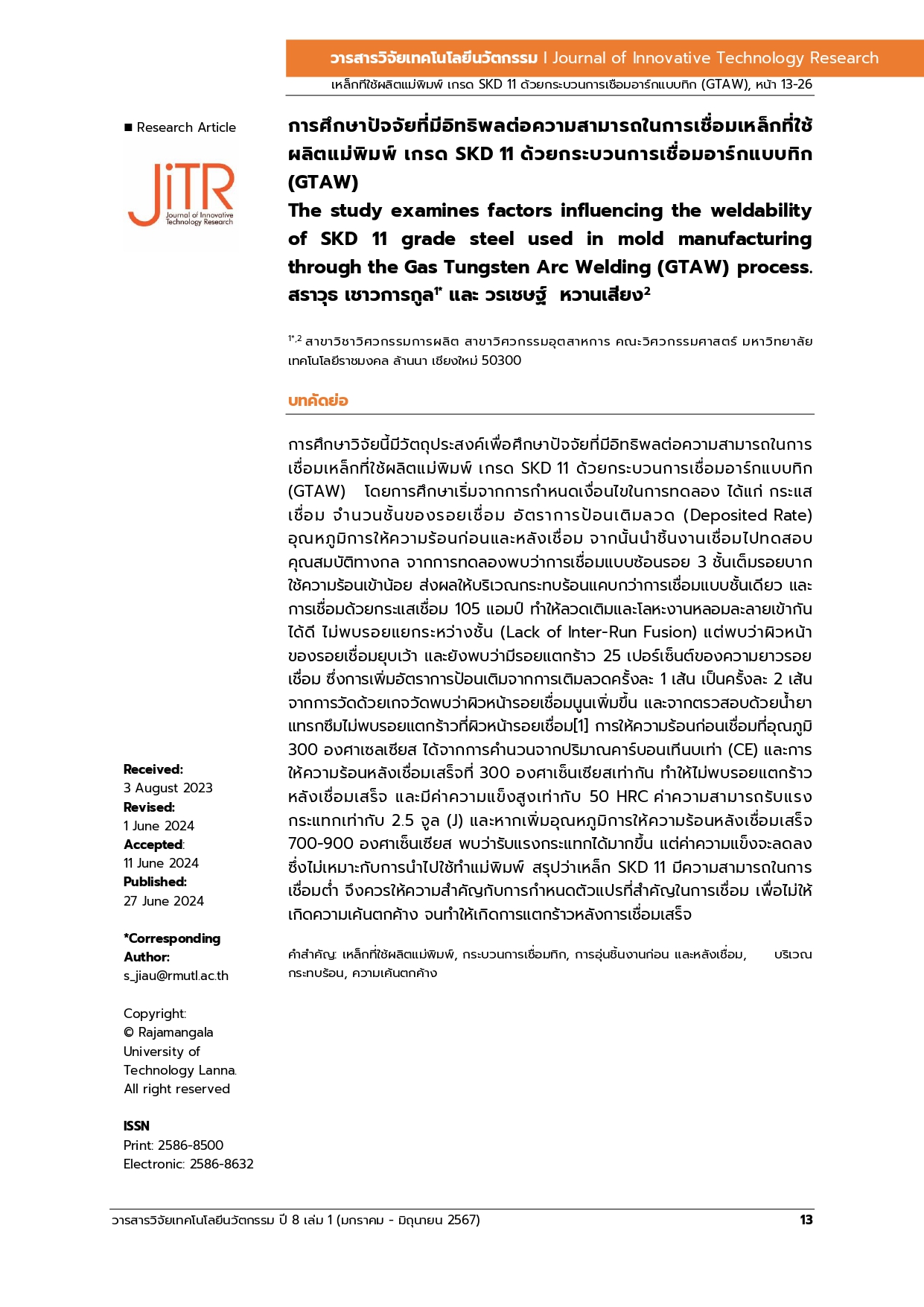การศึกษาปัจจัยที่มีอิทธิพลต่อความสามารถในการเชื่อมเหล็กที่ใช้ผลิตแม่พิมพ์ เกรด SKD 11 ด้วยกระบวนการเชื่อมอาร์กแบบทิก (GTAW)
คำสำคัญ:
เหล็กที่ใช้ทำแม่พิมพ์, กระบวนการเชื่อมทิก, การอุ่นชิ้นงานก่อน และหลังเชื่อม, บริเวณกระทบร้อน, ความเค้นตกค้างบทคัดย่อ
การศึกษาวิจัยนี้มีวัตถุประสงค์เพื่อศึกษาปัจจัยที่มีอิทธิพลต่อความสามารถในการเชื่อมเหล็กที่ใช้ผลิตแม่พิมพ์ เกรด SKD 11 ด้วยกระบวนการเชื่อมอาร์กแบบทิก (GTAW) โดยการศึกษาเริ่มจากการกำหนดเงื่อนไขในการทดลอง ได้แก่ กระแสเชื่อม จำนวนชั้นของรอยเชื่อม อัตราการป้อนเติมลวด (Deposited Rate) อุณหภูมิการให้ความร้อนก่อนและหลังเชื่อม จากนั้นนำชิ้นงานเชื่อมไปทดสอบคุณสมบัติทางกล จากการทดลองพบว่าการเชื่อมแบบซ้อนรอย 3 ชั้นเต็มรอยบาก ใช้ความร้อนเข้าน้อย ส่งผลให้บริเวณกระทบร้อนแคบกว่าการเชื่อมแบบชั้นเดียว และการเชื่อมด้วยกระแสเชื่อม 105 แอมป์ ทำให้ลวดเติมและโลหะงานหลอมละลายเข้ากันได้ดี ไม่พบรอยแยกระหว่างชั้น (Lack of Inter-Run Fusion) แต่พบว่าผิวหน้าของรอยเชื่อมยุบเว้า และยังพบว่ามีรอยแตกร้าว 25 เปอร์เซ็นต์ของความยาวรอยเชื่อม ซึ่งการเพิ่มอัตราการป้อนเติมจากการเติมลวดครั้งละ 1 เส้น เป็นครั้งละ 2 เส้น จากการวัดด้วยเกจวัดพบว่าผิวหน้ารอยเชื่อมนูนเพิ่มขึ้น และจากตรวสอบด้วยน้ำยาแทรกซึมไม่พบรอยแตกร้าวที่ผิวหน้ารอยเชื่อม[1] การให้ความร้อนก่อนเชื่อมที่อุณภูมิ 300 องศาเซลเซียส ได้จากการคำนวนจากปริมาณคาร์บอนเทีนบเท่า (CE) และการให้ความร้อนหลังเชื่อมเสร็จที่ 300 องศาเซ็นเซียสเท่ากัน ทำให้ไม่พบรอยแตกร้าวหลังเชื่อมเสร็จ และมีค่าความแข็งสูงเท่ากับ 50 HRC ค่าความสามารถรับแรงกระแทกเท่ากับ 2.5 จูล (J) และหากเพิ่มอุณหภูมิการให้ความร้อนหลังเชื่อมเสร็จ 700-900 องศาเซ็นเซียส พบว่ารับแรงกระแทกได้มากขึ้น แต่ค่าความแข็งจะลดลงซึ่งไม่เหมาะกับการนำไปใช้ทำแม่พิมพ์ สรุปว่าเหล็ก SKD 11 มีความสามารถในการเชื่อมต่ำ จึงควรให้ความสำคัญกับการกำหนดตัวแปรที่สำคัญในการเชื่อม เพื่อไม่ให้เกิดความเค้นตกค้าง จนทำให้เกิดการแตกร้าวหลังการเชื่อมเสร็จ
เอกสารอ้างอิง
Kou,S. (2003). Improving Weld Geometry.Welding metallurgy.(pp.
-295) New Jersey USA : John Wiley & Sons, Inc.
เฉลิมพล คล้ายนิล, & ณัฐศักดิ์ พรพุฒิศิริ. (2558) การศึกษาชนิดของ
เหล็กกล้าเครื่องมือที่มีผลต่อพฤติกรรมการสึก หลอของแม่พิมพ์สำหรับการปั้ม
เหล็กกล้าความแข็งแรงสูง. CMUL: Journal Articles.
http://cmuir.cmu.ac.th/jspui/handle/6653943832/64792.
STEVE THOMPSON. (1999). Handbook of mold, tool and die repair
welding. United States of America: William Andrew Publishing.
Lin, Y. C., Chen, H. M., & Chen, Y. C. (2014). A Comparative Study
of the Tribological Behavior of Tin Powder Clad on the JIS SKD11
Tool Steel with the GTAW Method. Advanced Materials
Research, 966, 365-376.
https://doi.org/10.4028/www.scientific.net/AMR.966-967.365.
ดำรงค์ มิตรเหียนขุนทด. อิทธิพลของวัฏจักรความร้อนที่มีผลต่อโลหะเชื่อมมิก
เหล็กกล้าเครื่องมือเกรด SKD11 (Doctoral dissertation, มหาวิทยาลัย
เทคโนโลยีราชมงคลธัญบุรี. คณะวิศวกรรมศาสตร์. สาขาวิชาวิศวกรรมการ
ผลิต).
http://www.repository.rmutt.ac.th/xmlui/handle/123456789/2400.
Meng, Y., Zhang, J. Y., Zhan, H., Chen, Q., Zhou, J., Sugiyama, S.,
& Yanagimoto, J. (2019). Effects of subsequent treatments on the
microstructure and mechanical properties of SKD11 tool steel
samples processed by multi-stage thixoforging. Materials
Science and Engineering: A, 762, 138070.
https://doi.org/10.1016/j.msea.2019.138070.
Chuaiphan, W., & Srijaroenpramong, L. (2014). Effect of welding
speed on microstructures, mechanical properties and corrosion
behavior of GTA-welded AISI 201 stainless steel sheets. Journal
of Materials Processing Technology, 214(2), 402-408.
https://doi.org/10.1016/j.jmatprotec.2013.09.025.
Olabi, A. G., & Hashmi, M. S. J. (1995). The effect of post-weld
heat-treatment on mechanical-properties and residual-stresses
mapping in welded structural steel. Journal of materials
processing technology, 55(2), 117-122.
https://doi.org/10.1016/0924-0136(95)01794-1.
Kim, H., Kang, J. Y., Son, D., Lee, D. S., Lee, T. H., Jeong, W. C., &
Cho, K. M. (2014). Microstructures and mechanical properties of
cold-work tool steels: a comparison of 8% Cr steel with STD11.
Journal of the Korean Society for Heat Treatment, 27(5), 242-
https://doi.org/10.12656/jksht.2014.27.5.242.
Mandolfino, C., Lertora, E., Davini, L., & Gambaro, C. (2014).
Investigation on gas metal arc weldability of a high strength
tool steel. Materials & Design (1980-2015), 56, 345-352.
https://doi.org/10.1016/j.matdes.2013.11.042.
Fukaura, K., Sunada, H., Yokoyama, Y., Teramoto, K., Yokoi, D., &
Tsujii, N. (1998). Improvement of strength and toughness of
SKD11 type cold work tool steel. Tetsu-to-Hagané, 84(3), 230-
https://doi.org/10.2355/tetsutohagane1955.84.3_230.
คณิต สิทธิพันธ์. อิทธิพลของการเชื่อมอาร์กลวดหุ้มฟลักซ์พอกแข็งซ้ำแนวต่อ
สมบัติของเหล็กกล้าเครื่องมือ JIS-SKD11 (Doctoral dissertation,
มหาวิทยาลัย เทคโนโลยี ราช มงคล ธัญบุรี. คณะ วิศวกรรมศาสตร์. สาขา
วิชา วิศวกรรม การ ผลิต.).
http://www.repository.rmutt.ac.th/xmlui/handle/123456789/2588.
สมหมาย สารมาท. (2550). การวิเคราะห์ปัจจัยเพื่อกำหนดวิธีปฏิบัติในการเชื่อม
แบบทังสเตนอาร์คเพื่อลดการแตกร้าวสำหรับ เหล็กกล้าเครื่องมืองานเย็นเอ
สเคดี 11. (วิทยานิพนธ์ ปริญญามหาบัญฑิต). เชียงใหม่. บัณฑิตวิทยาลัย
มหาวิทยาลัยเชียงใหม่
http://cmuir.cmu.ac.th/jspui/handle/6653943832/26911
Kutelu, B. J., Seidu, S. O., Eghabor, G. I., & Ibitoye, A. I. (2018).
Review of GTAW welding parameters. Journal of Minerals and
Materials Characterization and Engineering, 6(05), 541.
http://creativecommons.org/licenses/by/4.0/.
Dubey, Y., Sharma, P., & Singh, M. P. (2023). Experimental
investigation for GTAW optimization using genetic algorithm on
S-1 tool steel. Materials Today: Proceedings.

ดาวน์โหลด
เผยแพร่แล้ว
รูปแบบการอ้างอิง
ฉบับ
ประเภทบทความ
สัญญาอนุญาต
ลิขสิทธิ์ (c) 2024 สถาบันวิจัยและพัฒนา มหาวิทยาลัยเทคโนโลยีราชมงคลล้านนา

อนุญาตภายใต้เงื่อนไข Creative Commons Attribution-NonCommercial-NoDerivatives 4.0 International License.
กองบรรณาธิการขอสงวนสิทธิ์ในการปรับปรุงแก้ไขตัวอักษรและค่าสะกดต่าง ๆ ที่ไม่ถูกต้อง และต้นฉบับที่ได้รับการตีพิมพ์ในวารสารเทคโนโลยีและนวัตกรรม ถือเป็นกรรมสิทธิ์ของสถาบันวิจัยและพัฒนา มหาวิทยาลัยเทคโนโลยีราชมงคลล้านนา และผลการพิจารณาคัดเลือกบทความตีพิมพ์ในวารสารให้ถือเป็นมติของกองบรรณาธิการเป็นที่สิ้นสุด




